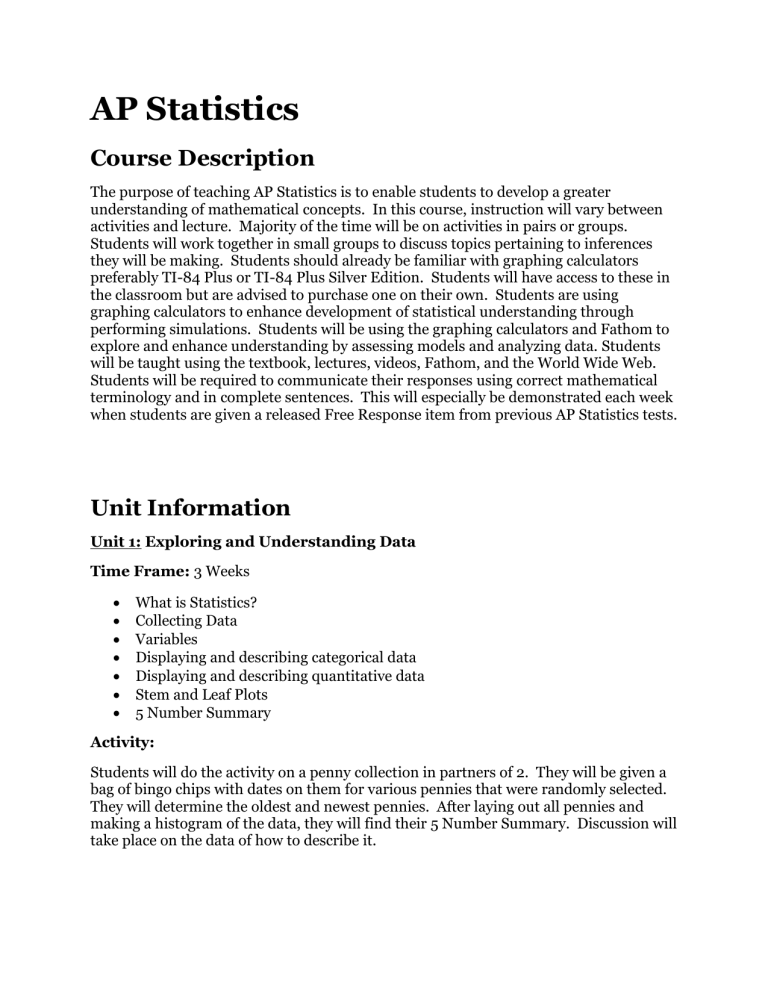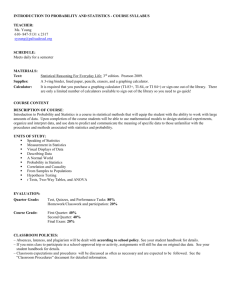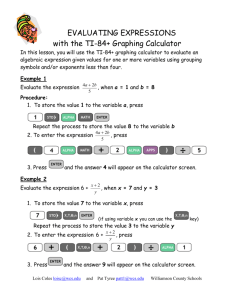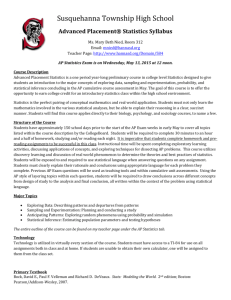AP Statistics Course Description The purpose of teaching AP

AP Statistics
Course Description
The purpose of teaching AP Statistics is to enable students to develop a greater understanding of mathematical concepts. In this course, instruction will vary between activities and lecture. Majority of the time will be on activities in pairs or groups.
Students will work together in small groups to discuss topics pertaining to inferences they will be making. Students should already be familiar with graphing calculators preferably TI-84 Plus or TI-84 Plus Silver Edition. Students will have access to these in the classroom but are advised to purchase one on their own. Students are using graphing calculators to enhance development of statistical understanding through performing simulations. Students will be using the graphing calculators and Fathom to explore and enhance understanding by assessing models and analyzing data. Students will be taught using the textbook, lectures, videos, Fathom, and the World Wide Web.
Students will be required to communicate their responses using correct mathematical terminology and in complete sentences. This will especially be demonstrated each week when students are given a released Free Response item from previous AP Statistics tests.
Unit Information
Unit 1: Exploring and Understanding Data
Time Frame: 3 Weeks
What is Statistics?
Collecting Data
Variables
Displaying and describing categorical data
Displaying and describing quantitative data
Stem and Leaf Plots
5 Number Summary
Activity:
Students will do the activity on a penny collection in partners of 2. They will be given a bag of bingo chips with dates on them for various pennies that were randomly selected.
They will determine the oldest and newest pennies. After laying out all pennies and making a histogram of the data, they will find their 5 Number Summary. Discussion will take place on the data of how to describe it.
Unit 2: Standard Deviation
Time Frame: 2 Weeks
Properties of Standard Deviation
Standardized Scores
Normal Distributions
Activity:
Students will work through the discovery activity on the mean and standard deviation in partners of 2.
Unit 3: Exploring Relationships between Variables
Time Frame: 4 Weeks
Scatter plots
Correlation
Linear Regression
Least Squares Regression Line
Outliers
Re-expression using logarithms
Activity:
Students will work through “finding the correlation without the calculator” lab in groups and then come together as a whole to put all the data together. Students will also work through another lab on the least square regression line in pairs of 2.
Unit 4: Gathering Data
Time Frame: 4 Weeks
Simulations by calculator-to look at sample data
Bias
Randomizing
Simple Random Samples
Blocking
Control Group
Activity:
Students will work through the Rolling Down the River Activity. In this activity they pull random samples by using the calculator to simulate random numbers from a population to set up various types of samples. Then the students will compare the samples to each other to see which would be the most appropriate to use. This activity will be done in pairs of two.
Unit 5: Randomness and Probability
Time Frame: 4 Weeks
Sample Space
Law of Large Numbers
Theoretical Probability
Addition Rule
Multiplication Rule
Independence vs. Dependence
Random Variables
Probability Models
Activity:
Students will design their own project for probability. McDonalds has little mini beanie babies in their Happy Meals. There are 12 different animals. We want to see what the probability of getting the hamster would be both theoretically and experimentally.
Students will be in lunch randomly sampling students as they go through line. Each student that goes through line will choose randomly an animal. The data will be recorded and we will then find the probabilities. We will look at the data separately of each group then we will put the data together looking for the Law of Large Numbers.
Unit 6: Sampling Distributions
Time Frame: 3 Weeks
Central Limit Theorem
Activity:
Students will be in pairs of two for this Unit’s project. They will be given a bag of bingo chips that are pre-numbered for various distributions. They will first take samples of 5 from the population of their bag 50 times. Then they will take samples of 10 from the population of their bag 50 times. The students will then graph these two sets of data as histograms and as box plots. Then they will lay out the entire population and see what type of distribution the population is. They will then graph their population as a histogram and a box plot. After this we will take a picture for the wall and have a
Central Limit Theorem Party. This will all be followed up with using a website that will animate it for them.
Unit 7: Confidence Intervals
Time Frame: 3 Weeks
Confidence Intervals
Margin of Error
One Proportion z interval
Hypothesis testing (null and alternative)
P-Values
Z test for population mean
Two sided test
Alpha level
Type I and Type II errors
Activity:
Students will look at the record of the Pendleton County Boys basketball team and determine if there is really a “home court” advantage. Students will interpret their results and prepare a written document that supports their conclusions in full sentences.
Unit 8: Inference for Two Proportions
Time Frame: 4 Weeks
Two proportion z-test
Two proportion z-interval
Sampling distribution
One sample t-test
One sample t-interval
Degrees of Freedom
Two sample t-interval
Two sample t-test
Pooling
Activity:
Students will do a random survey of students to see if they bought a used IPod from a friend if they would pay the same as if they bought it from a stranger. They will then do a two-sample t-test to determine if there is a difference. Students will work in groups of
4 for this activity.
Students will design their own project and determine which type of test to use. They will work through the entire process of performing either a t-test or a z-test. Students will interpret their results and prepare a written document that supports their conclusions in full sentences.
Unit 9: Inference when Variables are Related
Time Frame: 2 Weeks
Chi-Squared test o Goodness of Fit o Test for Homogeneity o Test for Independence
Two way tables
Contingency table
Activity:
In this Unit, students will be using the Chi-Squared test to do a project with M&M’s. We will take a large bag of regular M&M’s and randomly give them to each student. The students will count their colors and using the information we have about how many
M&M’s are supposed to be in a bag we will test if the hypothesis is correctly stated by the
Mars Candy Company.
Unit 10: Inferences for Regression
Time Frame: 3 Weeks
T-test for regression slope
Confidence Interval for regression slope
Activity:
Students will work through previously released AP Statistics test questions on
Inferences for Regression. The graphing calculator is required to solve this problem and students must submit their responses in written sentences.
Text Book
Title: Stats: Modeling the World 3 rd Edition
Publisher: Addison Wesley
Published Date: 2010
Author: David E. Bock
Second Author: Paul F. Velleman
Third Author: Richard D. De Veaux
Other Course Materials
Material Type: Graphing Calculator
Description: TI-84 Plus Silver Edition
Material Type: Computer Software
Description: Fathom Data Software
Websites
URL: http://onlinestatbook.com/stat_sim/sampling_dist/index.html
Description: I will be using this website after the introduction of the Central Limit
Theorem. Students will first do a group project looking at various data samples and then we will have our Central Limit Theorem Party. After the party, students will use the website to emphasize what they have learned.
Grading Scale
Advanced Placement classes are graded on a weighted scale that can be found in your Student Agenda. Work for the class will be graded as follows:
Tests: (100 Points) There will be one test for each unit that is covered. This test will be both multiple choice and free response questions taken from a released AP exam.
Quizzes: (50 Points) Quizzes may or may not be announced.
Projects: (Depends on depth of project) There will be one project a unit that the students will either work on in class or out of class with a partner or group.
Homework: (10 Points) Homework will be given daily so students can practice the material discussed in class. Math is a subject that you must learn by doing; therefore completing homework ensures that learning is taking place.
Weekly AP Statistics Exam Work: (20 Points) Each week students will be given a few multiple-choice and 1 Free Response question that has been released from a previous AP Statistics exam. These will be due by the end of the week and given back on
Monday.
Supply List
1 ½ inch Binder
Dividers for Binder
Loose-Leaf Paper
Pencils
Graphing Calculator (Preferably TI-84 Plus Silver Edition)
Tutoring
Tutoring is provided on Tuesdays for AP Statistics only in my room 725.
Inclusion Statement
Honors/Pre-AP and Advanced Placement classes are intended for students who have exceptional abilities and/or interests in particular areas of study that require differentiated services. The classes are designed to provide additional challenge for the student who accepts responsibility for active involvement in their own learning. Students should be willing to demonstrate the necessary task commitment to maintain satisfactory progress (“C” average or better each grading term). Failure to keep pace and maintain satisfactory progress may result in removal from the course.
Please at anytime call me or email me with any comments, questions, or concerns at
654-3355 x725 or marsha.caldwell@pendleton.kyschools.us
and I will return your message as soon as possible.
AP Statistics
Course Syllabus 2012-2013
Ms. Marsha Caldwell
I have read and understand each of the rules for this class. By signing below I, as a student, promise to remember and follow the rules and understand that if I do not I will have to follow the consequences. Also parents, signing below shows that you understand the rules your child will follow and understand that if he/she does not what consequences will be followed.
Student Signature, Date
Parent/Guardian Signature, Date
Parent Email Address
Parent Phone Number (that can be contacted at any time)
Please feel free to make any comments or questions you may have below:










